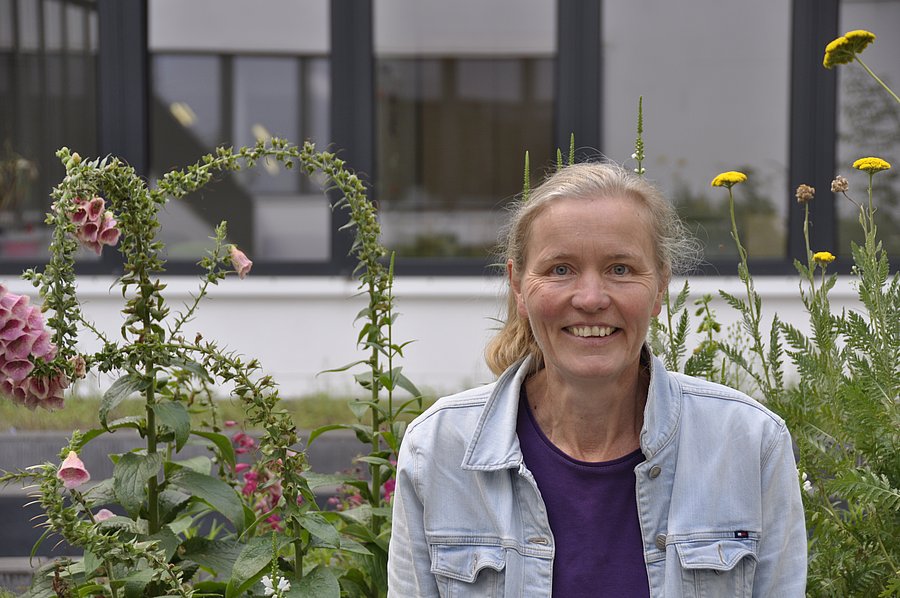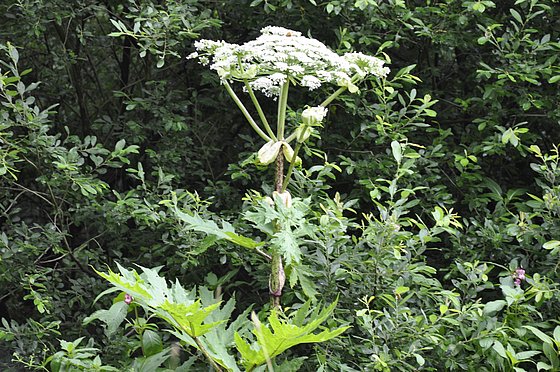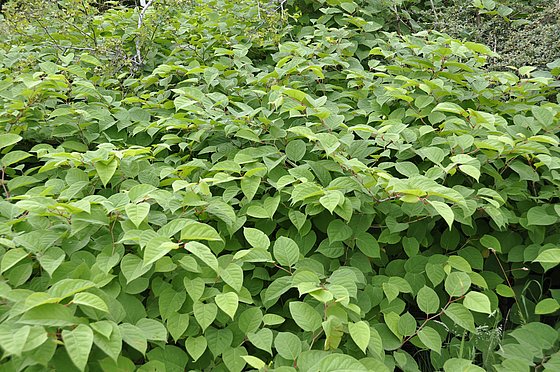
Prof. Dr. Gertrud Lohaus / Botany
Photo: UniService Transfer
Plants from all over the world in the Bergisch Land
The botanist Prof. Dr. Gertrud Lohaus on imported plants whose growth is further enhanced by the climate change
They have such fantastic names as green foxtail, snapdragon, red spurge, rock cranesbill or yellow-brown daylily and are at home in many gardens. Hardly anyone knows that these flowering plants did not come to us until the 16th century from the Mediterranean or Asia, among other places. Many other plants have found their way to Europe to this day, which are actually based elsewhere.
"After Columbus landed in America, there was a huge exchange between the new continent and Europe/Eurasia," explains the botanist Professor Dr. Gertrud Lohaus, who heads the subject Molecular Plant Research/Plant Biochemistry in the Faculty of Mathematics and Natural Sciences at the University of Wuppertal. "Plants that reached other areas after 1492 through human influence are called neophytes." In Germany these are about 1,000 higher vascular plants, of which about 400 are established and about 40 are considered invasive. They feel comfortable in our latitudes, change the landscape and also the species composition. The scientist knows where to find them. "On the riverbanks, for one thing. The Japanese knotgrass, for example, can be found on the Wupper River, and the giant hogweed, also known as Hercules herb, can also be found on riverbanks. There are a few on the Gelpe," she says. "On the edges of the forest you can find the glandular balsam, while on ruderal sites, i.e. fallow land and in cracks in the pavement, the narrow-leaved grey cabbage blooms. Lohaus also mentions various types of evening primrose, which come from America and the Canadian goldenrod, which was very popular among beekeepers. "Then there are the archaeophytes", she adds "these are plant species 'introduced' before 1492, mostly crop plants, like almost all cereals, which were spread with the Neolithic revolution and the migrations."
New plants often grow and flower in areas where they do not disturb anyone. Whether on the motorway, on construction areas, at railway stations or in gaps between houses, the most beautiful plays of colour can be found. But they also grow where you do not like to see them. "The problem exists with areas that one would like to preserve," explains Lohaus "the so-called sandy or lime-lean grasslands. These are low-nutrient areas in which certain species, such as special orchids grow. These areas are among the most exciting for botanists, i.e. very valuable areas, and plants such as the Japanese knotgrass or the narrow-leaved grey-weed are not so liked to be seen there.

The giant hogweed originates from the Caucasus
Health impairments, on the other hand, are caused for example by the Hercules plant, because touching it causes rashes or burns. As an unpleasant plant that originally comes from the Caucasus the giant hogweed, which was even voted poison plant of the year in 2008 is also found in Wuppertal's alluvial landscapes. "The giant hogweed can grow up to three metres tall and contains photosensitising substances of the group of substances furanocoumarins. When exposed to sunlight, i.e. UV radiation, these substances have a phototoxic effect and burn the skin," said Lohaus. In contrast, nothing happens when the skin is touched in the darkness. Therefore, the plant should only be cut professionally. Close relatives are the small hogweed, which also belongs to the umbelliferae family, as well as the edible celery and parsley.

Preparing instead of destructing
Some of these introduced plants are almost familiar to us. Although we do not know their names we consider them as native, such as the Japanese knotweed or the Indian spring chew. In many places, these plants are combated in order to preserve the species composition of certain biotopes. But the botanist from Wuppertal does not agree with this radical method and says: "You don't have to fight them in every ecosystem. But the Japanese knotgrass is very fast-growing and rampant. It grows 10-30 cm per day. It also forms rhizomes, i.e. underground shoots. Even small pieces of it can grow out again, i.e. everything that remains in the soil even parts of uprooted plants will grow out again. It shades everything below itself and nothing else grows anymore. The only way to dispose of it safely is to incinerate it." But another use would also be conceivable because the plant imported in 1825 as animal feed can even be eaten as a young plant. In its native country the knotgrass is cultivated and processed as a vegetable plant similar to our native rhubarb. Even the taste is similar to rhubarb and the preparation methods are the same. The young shoots of the Japanese knodweed taste good in both savoury and sweet dishes,such as compote or as fruit cake.
Plants know no boundaries
New plants often grow and flower in areas where they do not disturb anyone. Whether on the motorway, on construction areas, at railway stations or in gaps between houses, the most beautiful plays of colour can be found. But they also grow where you do not like to see them. "The problem exists with areas that one would like to preserve," explains Lohaus "the so-called sandy or lime-lean grasslands. These are low-nutrient areas in which certain species, such as special orchids grow. These areas are among the most exciting for botanists, i.e. very valuable areas, and plants such as the Japanese knotgrass or the narrow-leaved grey-weed are not so liked to be seen there.
Future trees
Among the most powerful representatives of plants are certainly the trees many of which have their origins outside Europe. A special guest that comes from North America is the Robinia, which was also chosen as tree of the year this year in Germany. "The Robinia was introduced to Germany and Central Europe about 400 years ago," Lohaus knows. "It came as an ornamental tree for parks and gardens and is today still frequently found along railway lines, because at the time when steam locomotives were still running there were frequent fires beside the rails. The Robinia has a very thick bark. It is a tree with finer foliage and if there is a quick fire it will raze out again. It is different with dry spruce, which burns brightly." What is remarkable, according to the scientist, is the fact that Robinia belongs to the same family as peas and beans, the butterfly blossom or legume plants. These are able to fix nitrogen, i.e. they do not necessarily need fertiliser because they live in symbiosis with certain bacteria and can use atmospheric nitrogen. "All in all, the Robinia is already a tree of the future in the sense that it can cope with many imponderables," Lohaus explains.
However, it is not a substitute for spruce, which is threatened by drought as its wood is used more as a substitute for tropical wood, whereas spruce is mainly used for construction. The Douglas fir, also a coniferous tree species, which is classified as an invasive species in NRW would then be more appropriate. Other scientists say that we also need to experiment with other tree species so-called future trees that can cope better with the drought," she continues, citing some examples that she has also planted in her Uniarboretum, which has been in existence for eight years. These include the bluebell tree from central and western China, the Chinese guttapercha tree also known as rubber elm, and the small Amur lime tree from Russia and China.
Patience is the central keyword here, and so there are also projects that investigate how our forests are changing over the years. Lohaus knows an example near Lübeck, where a forester leaves the forest to its own devices and observes which trees resettle by themselves and brave the new environmental conditions. Still others are concerned with the different varieties of certain trees that are more adapted to drought, because as the botanist says, "You would take any path you could, because the dying of the forest is very massive."
Elaborate control measures
At the North Sea the potato rose causes problems for the dune biotopes, in Berlin allotment gardeners fight against the Tree of God and the mugwort ambrosia can cause allergies in humans. "This is indeed a difficult problem," Lohaus knows and explains the difficulties using the example of the potato rose. "The potato rose is found in the dunes on many North Sea islands. Where it blooms pink people also wear pink glasses and think that is great. But it does not belong there and ruins a lot of other plants growing under it. You can hardly get rid of it because it has a very strong dissemination potential. It is strongly anchored in the ground. In one place an excavator was used to remove all the roses and soil, filtered the soil and brought it back. And when individual roses come along then you cut them out. An incredible effort. It is hard to get rid of the roses in a place where they already exist." It is even more problematic with plants that have real health problems. Mugwort ambrosia, which came to us from North America as birdseed can cause allergies due to its pollen. "Some people react so strongly to these allergens that a few pollen are enough to trigger an allergic reaction. There are even registration offices in many places," said Lohaus, who then has experts cut out the relevant specimens. "But", she adds "you have to recognize them first because they look quite harmless and green." As registration offices in NRW you can contact the State Office for Nature, Environment and Consumer Protection. Further information is provided by a warning list of invasive vascular plant species, which can be viewed at the Federal Agency for Nature Conservation, and the Neobiota Portal, which offers a list of plant species. And also the NABU Rhein-Berg-Kreis tries to do something against certain invasive species and is always happy about volunteers.
Online trading: curse and blessing?
What used to reach Europe via individual imports is now even more difficult to control via online trade. People want everything at all times. Some plant species are used agriculturally, as medicinal or ornamental plants and, if they are not available in specialist shops then they are ordered via the Internet. It is a danger for our ecosystems in the sense that more and more new plants will come and only afterwards you can see whether they will become invasive or not, says Lohaus. "Most plants have come for good reasons as food plants, screens, bee pasture, food, ornamental plants or park trees. It is all quite harmless. The extent of what is coming is relatively large, the exchange in the world is becoming more and more, and there may of course be other species that spread here. Almost all of our food consists of plants that were once introduced here," she explains, adding with a smile, "without these plants we would still be gnawing on oak bark."
Uwe Blass (Interview on 22.07.2020)
Prof. Dr. Gertrud Lohaus received her doctorate in 1995 at the Georg-August-University in Göttingen and worked there as a research assistant in the Department of Plant Biochemistry until 2004. From 2005 to 2009 she was first a lecturer, then a substitute professor for tree physiology and forest botany. In 2009 she took over the Professorship for Molecular Plant Research/Plant Biochemistry at the University of Wuppertal.
